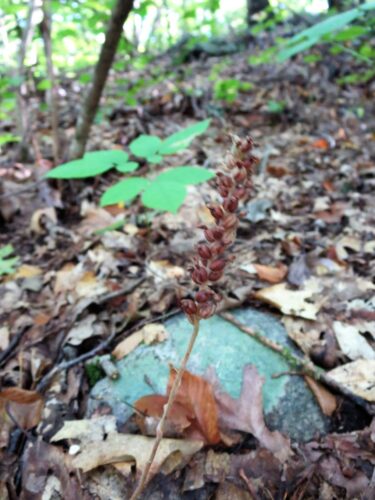It’s usually difficult to identify wildflowers when they aren’t in bloom, but sometimes they have such distinctive foliage that you can figure out what they are, even if you’ve never seen their flowers. Such was the case with the round-leaved pyrola that I found growing near my driveway and wrote about earlier this year. The appearance of its leaves (shape, markings, and texture) was enough for me to feel confident in identifying it. When the plant finally bloomed, it looked exactly as expected. If I was wrong about what it was, I was not far wrong. It was definitely a type of pyrola. I had promised that I would post a picture of it in bloom, and here it is.

6/20/2021
Spotted wintergreen is another plant that I identified without seeing its flowers. I have since seen in blooming, at night!

7/5/2021
Round-leaved pyrola and spotted wintergreen are similar. They enjoy the same growing conditions, and even sometimes grow together.

10/6/2021
But there is yet another plant that grows in the same area and that has dark green foliage marked with lighter veins.

10/6/2021

10/6/2021
The foliage and flower stalk are distinctive enough for me to feel safe making a guess about the identity of this plant. I believe that it’s downy rattlesnake plantain. Rattlesnake plantain is not related to the plantains that grow in my yard or to the pyrola and wintergreen. It is actually an orchid. Though common, it’s picky about where it grows, because it needs to be around certain types of fungi. If you’re interested in that, you can read more in this Smithsonian article about the relationship between orchids and fungi.
I hope to see rattlesnake plantain in bloom someday. In order to do so, I’ll have to go into the woods during the hottest, buggiest time of year (July-September), which is something I generally avoid doing. But, I found the rattlesnake plantains growing close to the edges of my property, so I wouldn’t have to trek far into the woods to hunt for the flowers.
I used to feel like my woods were lacking in wildflowers. That idea seems laughable now, as I’m sitting here writing my umpteenth blog post about local flowers. Looking back, I realize that I had several biases. The first was that I wasn’t counting the most common flowers, like goldenrod. Sure, goldenrod is common, but it’s still a wildflower, and it’s not just goldenrod–there are many varieties of goldenrod, each special in its own way. Another bias was that I was disappointed not to see certain flowers that I remembered from childhood, such as bloodroot, trillium, and Dutchman’s breeches. Those plants don’t grow here (as far as I know), but that doesn’t mean that we have any dearth of wildflowers. My third and most obvious bias was my reluctance to hike in the woods during the summer. Summer is the time when many wildflowers bloom, obviously. So I feel foolish for having thought that my woods were lacking, but grateful to have since found some many interesting flowers–orchids, even–growing here in my very own woods.

Pingback: Random Ramblings | Blue-Footed Musings
Pingback: SITY: Striped Wintergreen | Blue-Footed Musings
Pingback: Into the Woods | Blue-Footed Musings